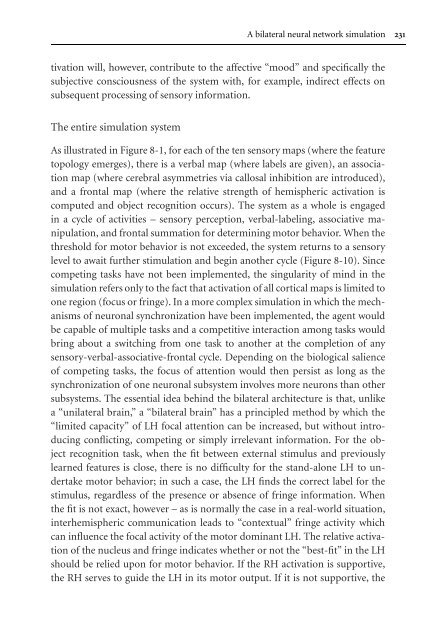Tone of Voice and Mind : The Connections between Intonation ...
Tone of Voice and Mind : The Connections between Intonation ...
Tone of Voice and Mind : The Connections between Intonation ...
You also want an ePaper? Increase the reach of your titles
YUMPU automatically turns print PDFs into web optimized ePapers that Google loves.
A bilateral neural network simulation 231<br />
tivation will, however, contribute to the affective “mood” <strong>and</strong> specifically the<br />
subjective consciousness <strong>of</strong> the system with, for example, indirect effects on<br />
subsequent processing <strong>of</strong> sensory information.<br />
<strong>The</strong> entire simulation system<br />
As illustrated in Figure 8-1, for each <strong>of</strong> the ten sensory maps (where the feature<br />
topology emerges), there is a verbal map (where labels are given), an association<br />
map (where cerebral asymmetries via callosal inhibition are introduced),<br />
<strong>and</strong> a frontal map (where the relative strength <strong>of</strong> hemispheric activation is<br />
computed <strong>and</strong> object recognition occurs). <strong>The</strong> system as a whole is engaged<br />
in a cycle <strong>of</strong> activities – sensory perception, verbal-labeling, associative manipulation,<br />
<strong>and</strong> frontal summation for determining motor behavior. When the<br />
threshold for motor behavior is not exceeded, the system returns to a sensory<br />
level to await further stimulation <strong>and</strong> begin another cycle (Figure 8-10). Since<br />
competing tasks have not been implemented, the singularity <strong>of</strong> mind in the<br />
simulation refers only to the fact that activation <strong>of</strong> all cortical maps is limited to<br />
one region (focus or fringe). In a more complex simulation in which the mechanisms<br />
<strong>of</strong> neuronal synchronization have been implemented, the agent would<br />
be capable <strong>of</strong> multiple tasks <strong>and</strong> a competitive interaction among tasks would<br />
bring about a switching from one task to another at the completion <strong>of</strong> any<br />
sensory-verbal-associative-frontal cycle. Depending on the biological salience<br />
<strong>of</strong> competing tasks, the focus <strong>of</strong> attention would then persist as long as the<br />
synchronization <strong>of</strong> one neuronal subsystem involves more neurons than other<br />
subsystems. <strong>The</strong> essential idea behind the bilateral architecture is that, unlike<br />
a “unilateral brain,” a “bilateral brain” has a principled method by which the<br />
“limited capacity” <strong>of</strong> LH focal attention can be increased, but without introducing<br />
conflicting, competing or simply irrelevant information. For the object<br />
recognition task, when the fit <strong>between</strong> external stimulus <strong>and</strong> previously<br />
learned features is close, there is no difficulty for the st<strong>and</strong>-alone LH to undertake<br />
motor behavior; in such a case, the LH finds the correct label for the<br />
stimulus, regardless <strong>of</strong> the presence or absence <strong>of</strong> fringe information. When<br />
the fit isnotexact,however– as is normally the case in a real-world situation,<br />
interhemispheric communication leads to “contextual” fringe activity which<br />
can influence the focal activity <strong>of</strong> the motor dominant LH. <strong>The</strong> relative activation<br />
<strong>of</strong> the nucleus <strong>and</strong> fringe indicates whether or not the “best-fit” in the LH<br />
should be relied upon for motor behavior. If the RH activation is supportive,<br />
the RH serves to guide the LH in its motor output. If it is not supportive, the


